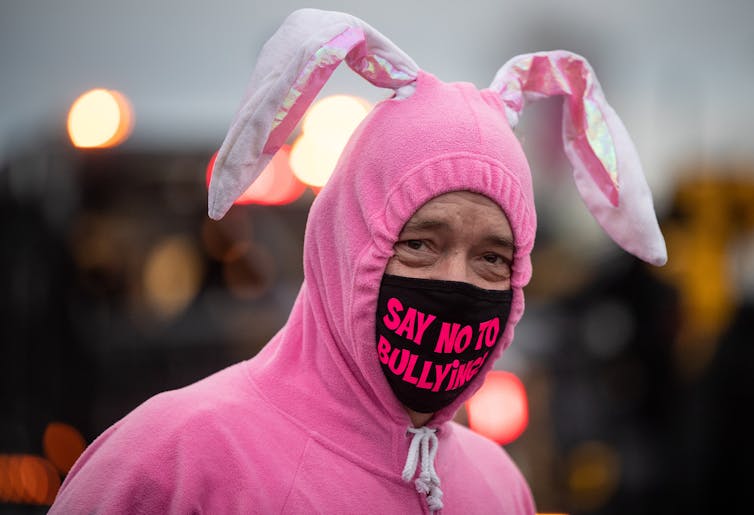As the last few days of February draw near, we will soon be called to think about bullying on Pink Shirt Day on the last Wednesday of the month. Pink Shirt Day was started by Grade 12 Nova Scotia students David Shepherd and Travis Price who wanted to show their solidarity for a victim of bullying who was targeted, in part, for wearing a pink shirt.
This initial show of solidarity has been a recognized day of action in Canada since 2007, and was adopted in New Zealand in 2009.
This means that we’ve had over 15 Pink Shirt Days. What have they done beyond raising awareness? Sadly, the answer is not much. Research shows that the number of youth who report being a victim of bullying hasn’t changed at all. The calls to action haven’t resulted in much change. We need to do better. The stakes are enormous.
Impacts of bullying
First the bad news: Bullying is notoriously difficult to prevent or reduce. Bullying is too often viewed as a rite of passage — the ability to overcome harassment and bad peer interactions. And it’s true that some stress is helpful in forging stronger social and emotional skills.
The same thing is true for bones that benefit from stressful exercise. But too much stress causes a bone to break, leaving behind a permanent weakness. The same is true for too much social and emotional stress.
Children are suffering decades-long negative physical and mental health outcomes because of stress caused by bullying. It changes the way the body reads its own DNA in response to stress well into one’s 50s.
These effects are actually worse for children in classes that otherwise have low levels of bullying. Those lone victims heartbreakingly feel even more isolated and to blame for their sole victimization. And for some, it can tragically result in taking their own lives.

Why people bully
Bullying, appears to be, at least in part, an evolutionary adaptation that can offer its users important benefits. First up are material benefits like the best spot on the playground, lunch money or a coveted scholarship. Even more appealing are the strong, consistent, longitudinal and cross-cultural ties between bullying and popularity. Bullying leads to gains in popularity and, sadly, popularity tends to lead to bullying.
Perhaps most salient of all, for both boys and girls, and both younger and older adolescents, bullying is associated with increased dating and sexual opportunities. Material benefits, popularity and sex are difficult motives to fight against. It gets even harder when we recognize that bullies are not socially unintelligent, they do not have lower self-esteem and they may not even lack emotional empathy.
They are often simply individuals who willingly choose to use power for their own benefit and to the detriment of others. And unfortunately, they get plenty of examples from adults about how bullying can get you what you want with few consequences so long as you’re powerful, rich or famous.
So if bullying is really so awful why has Pink Shirt Day not led to meaningful change?

Tackling bullying
Bullying is a facultative adaptation — that means it depends on the costs and benefits an environment affords. So even if it has a biological basis, its expression depends on the environmental context. And we know that different cultures, different classrooms and different peers can all change the equation of bullying so that its costs start to outweigh its benefits.
Critically, while data indicates bullies gain popularity and dominance, the same data shows that they lose out on being liked and on being sought out as a friend. People respect and fear a bully’s ability to violently wield power, but they don’t like it.
While bullying is hard to catch and harder to punish, we can look at changing the carrot instead of the stick. If peers stop rewarding bullies, and if adults create environments that foster prosocial co-operation rather than selfish competition, we can make bullying less appealing.
Read more: Bullying won't be curbed until we figure out what fuels it
Doing so is hard. It requires real work from youth, teachers, schools, parents, governments and the general public. We can’t expect youth to stop rewarding bullying if we continue to reward bullies as adults. We can’t expect youth to stand up to the most popular kids on their own.
We need to find the right ways to encourage the positive uses of power. Bullying may be an evolutionary adaptation, but it’s not genetically determined, so we should not accept it as an inevitable rite of passage.
This Pink Shirt Day, do more than just think about bullying. Think about how you can get involved and make a positive difference. Talk to your children, talk to their schools, talk to teachers that you know, stand up to bullies in your workplace. Pink Shirt Day started as a gesture of solidarity, as a means of taking back some of the power from bullies.
If we can view Pink Shirt Day as a call to action, instead of just another reminder, we can start changing things so that bullying becomes associated with another evolutionary term — extinction.

